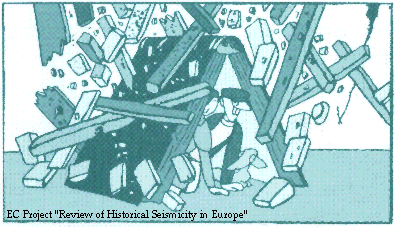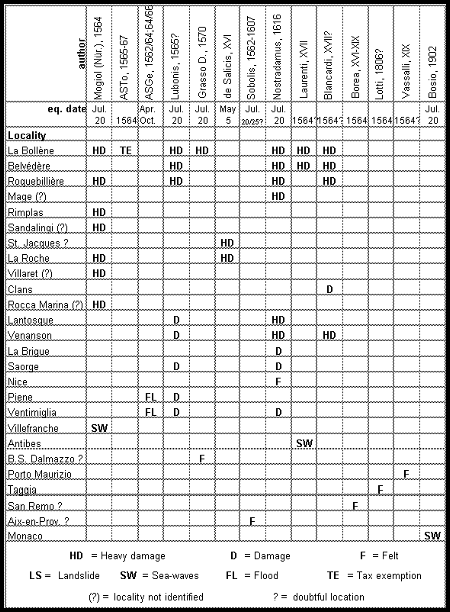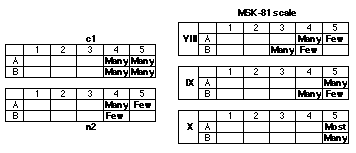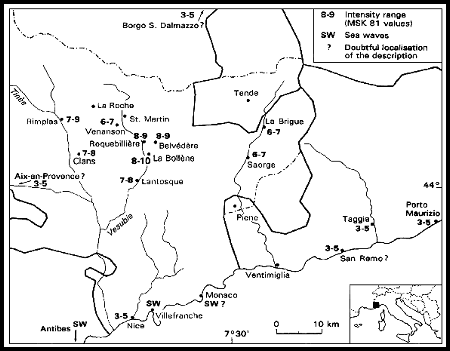
EC project "Review of Historical Seismicity
in Europe" (RHISE) 1989-1993

|
[Deliverables and queries] [Presentation] [Homepage] |
State-of-the-art
The 1564, Maritime Alps earthquake was investigated
in the frame of the RHISE project: Moroni and Stucchi (1993) reconsidered
the classical sources of the earthquake and investigated unpublished sources
for Piemonte; Lambert (1993) investigated the Nice area and the Provence,
while Rivara and Vaccari (1993) investigated the Ligurian area.
The picture of the earthquake is not very clear,
yet (Tab. 1). Some sources, apparently independent, confirm that an earthquake
happened on 1564, July 20; it damaged some towns of the Vesubie valley, was
felt in Piemonte, probably at Borgo S. Dalmazzo (Grasso Dalmazzo, 1570) and
could be felt as far as Aix-en-Provence (Sobolis, 1562-1607).
However, chronological problems are not completely
solved. In particular, de Salicis (XVI) reports damage occurred on May 5
only at S. Jacques (La Bolline), not reported explicitely by other sources,
and La Roche, also reported by Mogiol (1564). The wording used by de Salicis
suggests the possibility that a big landslide occurred in May 1564 in the
Valdeblore area, without relation to earthquakes.
According to most sources, the July 20 earthquake
certainly produced landslides, which probably took place during a number
of days or weeks, as it is normal in general and especially for this area
(Perriaux, 1927). Therefore, it might be that reporters, such as Mogiol (1564),
amalgamated descriptions related to various natural events as the result
of a single ìterremotoî.
The same explanation may also apply for Lubonis
(1565?), who writes almost one year after the earthquake and might amalgamate
earthquake reports from the Vesubie valley with reports from the Roya valley,
where damage reported at La Piene and Ventimiglia is not confirmed by archive
investigation (Rivara and Vaccari, 1993). On the contrary, the result of
this investigation suggests that Ventimiglia was flooded before the
earthquake (Spring 1564) and La Piene after (Autumn 1564).

Following these points, damage reported from
S. Jacques, La Roche, La Piene and Ventimiglia will not be considered here
as produced by the earthquake; for these localities intensity will not be
assessed.
Finally, some localities reported by Mogiol
(1564), Sandalingi, Villaret, Rocca Marina, have not yet been identified:
the same holds for Mage (Nostradamus, 1616). On the contrary, St. Martin
Vesubie, close to the most damaged area and today main town of it, is not
mentioned by any source.
Main sources
As described in the papers above mentioned,
the set of sources which can be used for intensity assessment is still rather
poor. Tab. 1 summarizes the main sources selected for intensity assessment
and the localities for which they supply records. Texts are given in the
Appendix.
Lubonis (1565?) seems the most reliable source,
once that problems related to Ventimiglia and La Piene are solved.
Mogiol (1564) map and letter were discussed
by Moroni and Stucchi (1993): beside the identification of some localities,
the earthquake records supplied are very poor and difficult to be used for
assessing intensity. However, Rimplas is quoted only by this source.
Grasso Dalmazzo (1570) only refers that the
earthquake was felt in Piemonte; the attribution of this record to Borgo
S. Dalmazzo is due to the fact that his work mainly deals with this locality
and the nearby Cuneo. The same apply to Sobolis (1562-1607), whose records
may mean that the earthquake was felt in Provence and not necessarily in
Aix-en-Provence.
Nostradamus (1616) provides the only known record
mentioning Mage, La Brigue and Nice; his accounts for the other towns generally
amplify Lubonis' (1565?) report. Blancardi (XVII) provides the only known
record concerning Clans. Laurenti (XVII) reports, through Gioffredo (1692),
sea-waves in Antibes. A Sanremo chronicle (Borea, XVII-XIX) mentions the
earthquake, without relating it to the town itself.
Effects at Taggia, Porto Maurizio and Monaco
come only from later compilations: Lotti (1806?), Vassalli (XIX) and Bosio
(1902) respectively.
Intensity assessment
Procedures
Intensity will be assessed according to MSK-81.
The assessement presents the typical problems related to the use of this
scale for interpreting historical records; in particular, as sources do not
supply information concerning building types nor about damage share between
them, some assumptions will be made.
In principle, it seems reasonable to assume
that both A-type and B-type buildings existed in the area. As for the damage,
in many cases it cannot be easily referred to a single damage grade of the
scales: in general, two hypothesis, a conservative (c) and a
non-conservative one (n) will be made.
Sources generally refer damage to the totality
of the buildings, without distinctions; therefore, using the MSK-81 scale
two assumptions can be made
for the damage share:
- damage is equally shared between A-type and
B-type buildings (1);
- for the same damage grade, damage is larger
for A-type than for B-type buildings (2).
By the way, using the EMS-92 scale (Grünthal,
1993), the first assumption becomes equivalent to the second one under the
further assumption that most B-type buildings (MSK-81) were in a bad state
of repair and, therefore, they can be considered as belonging to vulnerability
class A (EMS-92).
Considering all possible combinations of
assumptions, large intensity ranges (such as 7-9, meaning uncertainty between
7 and 9) can result: such ranges may be reduced if one has good reasons to
stick to some precise assumptions.
La Bollène
This locality seems, without any doubt, the
one which suffered the heaviest damage. Following the descriptions (Lubonis:
"omnino devastatus et diruptus remansit"; Nostradamus: "La Boullene
entierement et de fond en comble ruynée"), two damage distributions
can be supposed:

The first one assumes that all buildings suffered
damage of grade 4+5; the second one considers the description of the sources
as slightly exaggerated.
Coming to the problem of damage share between
A-type and B-type buildings, many theoretical distributions can be supposed.
Leaving out the unrealistic ones, the upper and lower boundary can be represented
by the following distributions c1 and n2 respectively which
can be compared to the degrees of the scale:

These distributions lead to degrees IX-X and VIII (MSK-81) respectively;
the same intensity range would be assessed if we assume that all buildings
were of A-type (MSK 81), or vulnerability class A (EMS-92). The other possible
distributions lead to intermediate figures. Therefore, intensity at La
Bollène ranges between VIII and X, with VIII-IX as the most probable
range.
Roquebillière and Belvédère
Following Lubonis' description ("in locis Rocabigliera et de Bello vedere
fero pro dimidia remansit dirupta"), two damage distributions can be
supposed:

In the same way as for La Bollène, the
upper and lower boundary can be represented by the following distributions:

Intensity at Roquebillière and
Belvédère ranges between VIII and IX.
Lantosque
Following Lubonis ("in loci autem Lantussie
nonnule domus ruinate et nonnulle aliquantulum minantur ruina Ö"),
two damage distributions can be supposed:

Once again, the upper and lower boundary can
be represented by the following distributions:

Clans
The source (Blancardi: "a Clans aver gettato
a terra quattordici case con grande uccisione di animali") refers about
heavy damage to 14 buildings, but does not supply elements for assessing
percentages. It seems reasonable to assume that Clans had a size similar
to Belvédère or Roquebillière. In such a case, 14 buildings
are between "Few" and "Many": an intensity VII-VIII follows.
Other localities
For Venanson, La Brigue and Saorge, damage
is related only to single buildings, which are not a primary choice for assessing
intensity: a tentative VI-VII can be proposed.
For Nice, Aix-en-Provence and Borgo San Dalmazzo the information does not
allow to say more than "Felt", which can be tentatively translated into a
range, such as III-V. The same holds for San Remo, Taggia and Porto Maurizio
(today Imperia), though the records are less reliable as they come from late
authors.
Following Mogiol (1564) an intensity at least of the same order of
Roquebillière should be assigned also to Rimplas (probable identification
of "Repella"); however, due to the poor description available, it seems more
reasonable to assess a large intensity range, such as 7-9. The same figure
can be proposed for the localities not identified (Sandalingi, Villaret and
Rocca Marina quoted by Mogiol, 1564; Mage quoted by Nostradamus, 1616).
Conclusions
The intensity distribution proposed
for the 1564 earthquake is presented in Fig. 1. The picture appears in some
way poorer than the previous one supplied by Cadiot (1980): this is mostly
due to the fact that some sources and records have been discarded by this
study for the reasons explained earlier.
Intensities appear in general lower and more uncertain than in the previous
study: the last point is due to the relative poorness of the records and
to the choice of making explicit the procedures and assumptions adopted for
assessing intensity.
Intensities in the most damaged area appears somewhat high with respect to
the effects in Nice and the localities where the earthquake was only felt.
This can be due to exaggerated reports or, simply, to the fact that the report
damage was the cumulative result of a long seismic sequence and of landslide
effects, at least at certain spots.
Finally, it is stressed again that assessing intensity from historical data,
mostly when they are so poor, requires either that assumptions are made
transparent for the users or that large uncertainties are accepted; in general,
intensity assessment should not be forced into sharp figures when data do
not support them.

Appendix
Mogiol (1564)
"... In dem hat sich ain seer hoher und grosser
Berg in der Mitten auffgethan / inn zway thail / mit solchem grewlichen und
schrocklichen anblick / gleich wie der Berg ETNA / der würfft für
und für feuer auff / gleicher werk diser Berg auch feuer flamen bis
an Himel ubersich auffwirfft / darob auch ain yegkliches gross Berg erschreckn
mag / und send durch disen grossen Erdbiden / Siben Stett verdorben und
untergangen / Das man nit das wenigest davon sehen kan / Nemlich dise Stett
/ ROCCA MARINA. REPELLA. SANDALINGI. ROCCA BALLIERA. VILLARET. MORENA und
ROCCIA. Auch so sein andere umbligende Stett unnd flecken in dem Tal und
gebirge dermassen verwürft unnd veredorben / Das die Lant sich beforchten
/ und den Mut nit haben zu bewonen / und das übrige Volk so in diesem
betrübten Jammer und Elend nicht ist umgekommen ..."
Lubonis (1565?)
"De admirabili hora et
horrendo terremotu in comitatu Niciense facto.
Anno ipsi millesimo quingentesimo
[quinquagesimo deleted]
sexagesimo quarto indictione septima et die iovis vigesima iulii circa
unam horam noctis fuit quidam terremotus in Comitatu Niciense absque tamen
aliquo damno veruntamen tota nocte per illius discursum sepius iterato ipso
terremotu in vale Lantusie qui adeo infremuit et impetum fecit ut locus Bolene
omnino devastatus et diruptus remansit ad quod omnes parietes domorum dirupte
sunt et duo partes ex tribus personarum eiusdem loci mortui sunt et fere
alia tertia pars remansit vulnerata in locis rocabigliera et de bello vedere
fere pro dimidia remansit dirupta et devastata adeo quod in loco Rocabigliera
mortui sunt viginti due et fere sexaginta vulnerati in loci de bello vedere
mortui sunt quinquaginta et totidem vulnerati in loci autem Lantussie nonnule
domus ruinate et nonnulle aliquantulum minantur ruina et mortui sunt tres
in loco autem Venanssoni eclesia parochialis ejusdem loci cum aliquibus domibus
ruinata fuit Curatus cum octo viris et duabus feminis intra dictam ecclesiam
mortuus est in loco Saurgi una pars Castri devastata fuit, Castrum pene dictionis
janue devastatum fuit, pars Castri Vigintimiglie pariter ruinata fuit et
quam pluries allii loci devastati fuerunt et continuavit ipse terremotus
per aliquot dies videlicet per ....adeo quod omnes persone dictorum locorum
adhuc degunt die ac nocte extra ipsa loca timentes mortem vicina non immerito
et tanta audiverunt in loco Bolene et in alliis locis quod omnes persone
remanent atonite cum timore magno et pluries persone mortue sunt ex rati
timore et damno per eas passo et terremotus ipse continuavit usque ad festum
pentecoste et sic fere per unum annum
a fol. 79 dicto, del prottocolo di Gio. Lubonis
del 1564."
in Scaliero (1792), page inserted between pp.
211-212.
Grasso Dalmazzo (1570)
"Il giorno 20 di lugno for fatto un terremoto
circa hore duoi di notte et alle 6 inanto l'alba, quali in queste nostre
bande del Piemonte non fecero alcun danno ma sopra il territorio di Terranova
cioé la Bolena con altre certe piccole terre per la ruina delle case
che cascorono per il detto terremoto, più di 300 persone tra morti,
feriti e stropiati restarono per esso terremoto durante hore 24."
Sobolis (1562-1607)
"Le XXe Julliet
[1564] au dit an fut faict terre
tremblant."
Nostradamus (1616)
"Desia le Soleil avoir passé iusques
au signe du Lyon, où il estoit bien avant entré lorque des
quartiers de Terre-neuve furent mandees au Comte de Tende certaines lettres
contenant plusieurs esclandres y advenus de ce temps, dont telles estoyent
les paroles.
Je cuyde que vous avez entendu la desolation
qui est en ces montaignes de Terre-neuve où sont peries iusques à
dix ou douze que villes que bourgades, et morts de huict à neuf cent
hommes, ayant commencé telle mortalité et fleau de Dieu le
vingt de Iuillet passé: si qu'une ville tombe aujourd'huy, l'autre
demain. Les montagnes se fendent par le milieu, les roches se brisent et
despecent, avec un bruit et tonnerre espouventable, de sorte que les pauvres
gens ne peuvent estre seurs ny avoir retraitte salutaire aux champs ny aux
villes. Le bestail demeure regardant au Ciel, comme implorant par quelque
instinct de nature, et mortelle necessité la souveraine
misericorde.
L'on entend dans les cavernes des grands
cris et des hurlemens effroyables: encore mesme Mecredy passé beaucoup
de maisons tomberent. Les deux tiers des habitans de Nisse couchent aux champs.
Une grande partie du Chasteau de Vintimille est tombé par terre, avec
la moytié du Convent. Somme que tous les quartiers des montagnes se
fendent d'heure en heure, et à yeux voyans, dont est grande desolation.
Escrit ce XX Iuillet MDLXIV.
En ce mesme temps passa par nostre ville
de Sallon, un qui se disoit de ces quartiers là, lequel racomptant
ces tristes choses et ces tant estranges prodiges, laissa un roolle en sa
langue naturelle et Nissarde qui est comme un vieil Provençal des
villes et chasteaux ruynez: en premier lieu Roche Begleure, et Mage où
estoyent restés morts et accablés sous les ruynes, iusques
au nombre de trois cens et plus, et trente blessés. Beauvers ruyné,
trois cens morts et d'avantage. La Boullene entierement et de fond en comble
ruynee, deux cens cinquante morts, et quatorze blessés. Lantousques
à moytié ruynee, tous les pauvres habitans morts et
accravantés, fors quatorze petits enfans. Venasque à moytié
ruynee, trente-huict de morts, et unze blessés. Outre cela le chasteau
de Cahours tombé avec le Pont, qui avoit cousté plus de cinquante
mille escus, et le pas dict Mont-taillat, qui faisoit le grand chemin de
Piedmont, lequel a deux grands Rochers fendus et taillez à force de
ferrements et de marteaux acerés, pour faire le grand chemin de Nisse,
et de Piedmont. S'estans ces rochers joincts et assemblés, entre lesquels
passoit une grosse et bbruyante riuiere, qui s'est enfondree et
perdue.
Davantage s'est ruyné le chasteau
de la Bregue, et y sont mortes plusieurs personnes. Ö"
Blancardi (XVII?) [from Gioffredo, 1692]
"Più distintamente nota Gio. Francesco
Blancardi di Sospello, aver questo terremoto fatto danno grandissimo alla
Bolena con morte di seicento persone, e quantità grande di bestiami;
a Belvedere aver ucciso 80 persone; a Roccabigliera molta gente sino dentro
la chiesa; lo stesso aver fatto a Venanzone: finalmente a Clans aver gettato
a terra quattordici case con grande uccisione di di animali."
Laurenti (XVII) [from Gioffredo, 1692]
"Onorato Laurenti, nel suo libro manoscritto
delle cose di Belvedere, parla di questo terremoto come di cosa per sempre
memorabile, dal quale afferma essere affatto stata rovinata la Bolena, e
gran parte di Belvedere, nel qual luogo per tal accidente dice, che molti
restarono oppressi dalle rovine, laddove nella Bolena morì la quarta
parte degli abitanti: aver trattenuto il corso della Vesubia, fiume per altro
molto rapido e impetuoso, lo spazio di una mezz'ora; aver fatte parecchie
fessure ed aperture profondissime nei monti, che parea aver diviso in due,
di dove uscivano tanti vapori, che causavano la notte tanti incendii, che
parevano un Mongibello: allora il mare a guisa d'un fiume essere corso tanto
innanzi, che coprì molte botteghe di Antibo, ed essere poi ritornato
tanto indietro, che quasi lasciò il porto senz'acqua."
References
ASGe (Archivio di Stato di Genova), 1562-64. Senato, Sala
Senarega. Litterarum dell'Antico Senato, f. 472.
ASGe, 1564-1566. Archivio Segreto. Litterarum. Foliacia,
f. 1965.
ASTo (Archivio di Stato di Torino), 1565-1567. Protocolli
notai ducali e camerali, vol. 226.
Blancardi, G. F., XVII. (unknown title). In: P. Gioffredo,
1692. Storia delle Alpi Marittime. ms., ASTo, Fondo mss.,
H.IV.26.
Borea, XVII-XIX. Manoscritto. N. L. (Editor), 1970. Il
manoscritto Borea. Cronache di Sanremo e della Liguria occidentale. Bordighera,
Istituto Internazionale di Studi Liguri.
Bosio, U., 1902. La Province des Alpes Maritimes. Anciens
comtés de Nice, de Vintimille et de Tende. Baronnie de Beuil et
Principauté de Monaco. Nice.
Cadiot, B., 1980. Monographie de quelques séismes
anciens (1356, 1428, 1564), Univ. Paris I - Sorbonne, Departement d'Histoire.
Mémoire de Maitrise.
de Salicis, G. A., XVI., Libri della Parrocchia di S. Giacomo
(?).
Gioffredo, P., 1692. Storia delle Alpi Marittime. ms., ASTo,
Fondo mss., H.IV.26.
Grasso Dalmazzo, 1570. Cronaca. D. Promis (Editor), 1871,
Miscellanea di Storia Italiana, XII.
Grünthal, G. 1993. European Macroseismic Scale 1992
(update MSK scale). Cahiers du Centre Européen de Géodinamique
et de Séismologie, 7, Luxembourg.
Lambert, J., 1993. The Catalonian (1428) and Alpine (1564,
1644) Earthquakes: Review of Research in France. In: M. Stucchi (Editor),
Materials of the CEC project "Review of Historical Seismicity in Europe",
Milano, 1, pp. 145-159.
Laurenti, O., XVII. Delle cose di Bellovedere (?). ms., unknown
location. In: P. Gioffredo, 1692. Storia delle Alpi Marittime. ms., ASTo,
Fondo mss., H.IV.26.
Lotti, V., 1806 ?. Materiali per servire all'Istoria di Taggia
raccolti dal canonico Vincenzo Lotti. ms., Bibliothéque Cessole,
Nice.
Lubonis, G. 1565 ?. De admirabili et horrendo terremotu in
civitatu niciense (unknown location). In: J. Scaliero,, 1792. La città
di Nizza insigne per li sacri monumenti. Ms., Archive Municipale, Nice, pp.
211-212.
Mogiol, F., 1564. Die Neue Zeytung von den sieben Stetten...,
single-leaf woodcut, Universitäts Bibliothek,
Friedrich-Alexander-Universität, Erlangen.
Moroni, A. and Stucchi, M., 1993. Materials for the investigation
of the 1564, Nice earthquake. In: M. Stucchi (Editor), Materials of the CEC
project "Review of Historical Seismicity in Europe", Milano, 1, pp.
101-125.
Nostradamus, C., 1616. Histoire de Provence. Lyon.
Perriaux, L., 1927. Les mouvements de terrain dans les Alpes
Niçoises, en novembre 1926. La catastrophe de Roquebillière.
Annales de Geographie, T. 36: 115-124.
Rivara, P. e Vaccari, E., 1993. Ricerca di documentazione
d'archivio sul terremoto del 20 luglio in Liguria occidentale. In: M. Stucchi
(Editor), Materials of the CEC project "Review of Historical Seismicity in
Europe", Milano, 1, pp. 127-143.
Scaliero, J., 1792. La città di Nizza insigne per
li sacri monumenti. ms., 3 vols., Archive Municipale, Nice.
Sobolis, 1562-1607. Histoire en forme de journal de ce qui
s'est passé en Provence depuis l'an 1562 jusq'uà l'an 1607.
Carpentras Library, ms. 540.
Vassalli N. F., XIX. private communication quoted by G. Mercalli,
1897. I terremoti della Liguria e del Piemonte. Napoli.
[Top]
[Vol.1]
[Vol.2]
[Deliverables and queries]
[Presentation]
[Homepage]